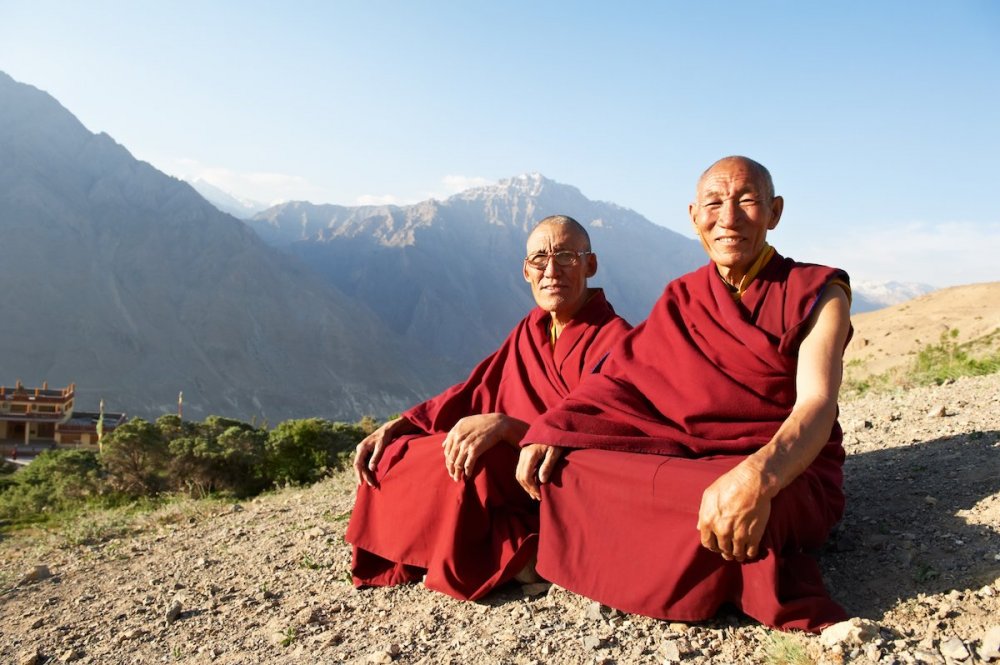The ancient technique of tummo breathing and meditation has been practised for decades by Tibetan monks in order to raise their body temperature. But could its benefits also extend to help stress-related conditions? Dee Marques finds out.
Most of us have struggled with anxiety or fear during our lives in one way or another. If you’re part of the happiness community, you’re probably already familiar with some common tools and techniques that can help reduce stress and worry.
In previous blog posts, we’ve covered breathing and meditation techniques like Tonglen or Kundalini. Now it's time to dive deep into another helpful method to feel centred and calm: tummo breathing and meditation.
Tummo breathing: the studies
Let’s start with a little background. Tummo, which is sometimes called Chandali yoga, is a Tibetan meditation technique that relies on a mix of breathing and visualization exercises. This ancient practice is mentioned in sacred texts dating back to the 8th century, where the word “tummo” means “heat”.
RELATED: Visualization Meditation – How to Practise It
The fact that tummo originated in Tibet isn’t a coincidence. Due to its high altitude, temperatures in the Tibetan plateau often drop below zero. You probably know how difficult it is to focus and relax when you feel cold, and this is something that Tibetan Buddhist monks had to deal with. The practice of tummo breathing and meditation emerged in response to this challenge, as its main purpose is to awaken the body’s inner fire.
As someone who is affected by low temperatures, I was intrigued about tummo breathing. After all, if we’re able to control body temperature, we’re also able to control other biological processes that interfere with our inner peace. But is it really possible to do this?
Tummo breathing originates from Tibetan monks
Well, according to science, yes: various studies confirm how tummo is able to do exactly what it claims. One in particular was conducted by researchers from Harvard University who had met the Dalai Lama during his visit to the United States. Throughout the 1980s, these researchers visited remote Buddhist monasteries in Tibet and northern India. Incredibly, they found that monks who practised tummo breathing could raise the temperature of their skin – by up to seven degrees.
This feat is even more astonishing when we consider the conditions under which these monks meditated. According to the study authors, they only wore basic woollen robes and slept outdoors directly on rocks, with no mattress or insulation other than their clothes. Overnight, temperatures dropped to up to -17C and the monks slept without so much as a shiver – thanks to tummo meditation and breathing.
Another study went even further by wrapping freezing-cold and wet sheets around the monks’ shoulders while they meditated with tummo. The results were the same: not even a shiver. Later on, magnetic resonance studies found that during meditation, the monks had an unusual blood flow in the brain area and they hypothesized that this allowed the brain to take over body functions like temperature and metabolism.
RELATED: Uncovering the Healing Power of the Breath
These findings point at the many uses of tummo breathing, even if we’re not Tibetan monks. One of the leading researchers in the studies stated that tummo meditation can deepen the connection between mind and body, and give us better tools to treat stress-related conditions, including high blood pressure, depression, insomnia and anxiety.
“Monks who practised tummo breathing could raise the temperature of their skin – by up to seven degrees.”
So, tummo is worth a try even if you've already practised other types of meditation, since it’s one more way to expand your range of stress-reducing tools. The more tools you have, the better equipped you’ll be to protect your well-being.
The benefits of tummo breathing
Being able to raise or maintain a reasonable body temperature is an interesting perk, but this is far from the main benefit or purpose of tummo breathing. In fact, tummo can give us a deeper appreciation of the mind-body connection and of how powerful our thoughts can be.
This practice can bring similar benefits involved in other breathing techniques, including a healthier stress response that benefits the immune system. Moreover, deep breathing can tone up the vagus nerve, which is responsible for controlling the correct functioning of several organs.
RELATED: Conscious Breathing: What Is It and How Do We Benefit From It?
And, if done regularly or in combination with other controlled breathing techniques, such as diaphragmatic breathing, tummo breathing can bring all the above benefits plus core stability, increased tolerance for high-intensity exercise, and a reduced risk of muscle injury.
How to practise tummo breathing
The basic idea is to tap into your internal energy through a series of breathing exercises and visualizations so that “psychic” heat becomes “actual” heat.
Suggested posture for tummo breathing and meditation
To start with, sit in a comfortable position. Before you start this session, exhale forcefully to clear any stagnant energy from the lungs. Then follow these steps:
- Bring your hands together in front of you and rub them energetically.
- When your hands are warm, place your left hand on your navel, and the right hand over it. Keep your hands in this position for the entire session.
- Start the first tummo breathing sequence: inhale deeply while pulling your shoulders back and letting the rib cage expand.
- Exhale loudly bringing your shoulders forward.
- Repeat the inhale-exhale sequence 3 or 4 times.
- Now switch to gentle breathing for a few seconds.
- Start the second sequence by inhaling deeply.
- Hold your breath for a couple of seconds and keep your shoulders square.
- Exhale, let your shoulders relax, and push your abdomen out.
- Repeat the inhale-exhale sequence 2 or 3 times.
- Switch to gentle breathing for a few seconds.
- Repeat the first sequence 5 times.
- Before you exhale for the last time, hold your breath for 2 seconds, then exhale slowly.
There’s a second version of tummo breathing where instead of pushing the abdomen out, you let it go back to its natural position. You can see a demonstration in this YouTube video, from minute 18:00 onward. The first part of the video demonstrates the exercise described above.
“Tummo breathing can give us better tools to treat stress-related conditions, including high blood pressure, depression, insomnia and anxiety.”
In Tibetan Buddhism, tummo breathing is accompanied by visualization exercises to further raise the body’s temperature. The main technique involves concentrating on images of flames or fire and associated them to key parts of the body. For example:
- Visualize the area surrounding the second chakra – a couple of fingers beneath the belly button – being fuelled by a fast-burning fire.
- Visualize the spinal cord as if it was made up of flames which rise up your body from the navel to the crown of the head.
- Visualize your hands and feet as if they were the sun, and focus on their radiating and warming effect.
The Takeaway: Tummo breathing
Tummo breathing and meditation is an ancient technique that can help establish a deeper connection between mind and body. Even if you’re not able to raise your body temperature like a Tibetan monk, tummo can be an interesting addition to your arsenal of meditation and relaxation techniques. •
Images: shutterstock/Dmitry Kalinovsky, shutterstock/kei907
Have you tried tummo breathing techniques? Let us know how it worked for you in the comments!
happiness.com | The fine art of being: learn, practice, share
Are you a happiness.com member? Sign up for free now to:
■ enjoy our happiness magazine
■ share and support in our happiness forum
■ develop with free online Academy courses
Written by Dee Marques
 A social sciences graduate with a keen interest in languages, communication, and personal development strategies. Dee loves exercising, being out in nature, and discovering warm and sunny places where she can escape the winter.
A social sciences graduate with a keen interest in languages, communication, and personal development strategies. Dee loves exercising, being out in nature, and discovering warm and sunny places where she can escape the winter.





Join the conversation
You are posting as a guest. If you have an account, sign in now to post with your account.
There are no comments to display.